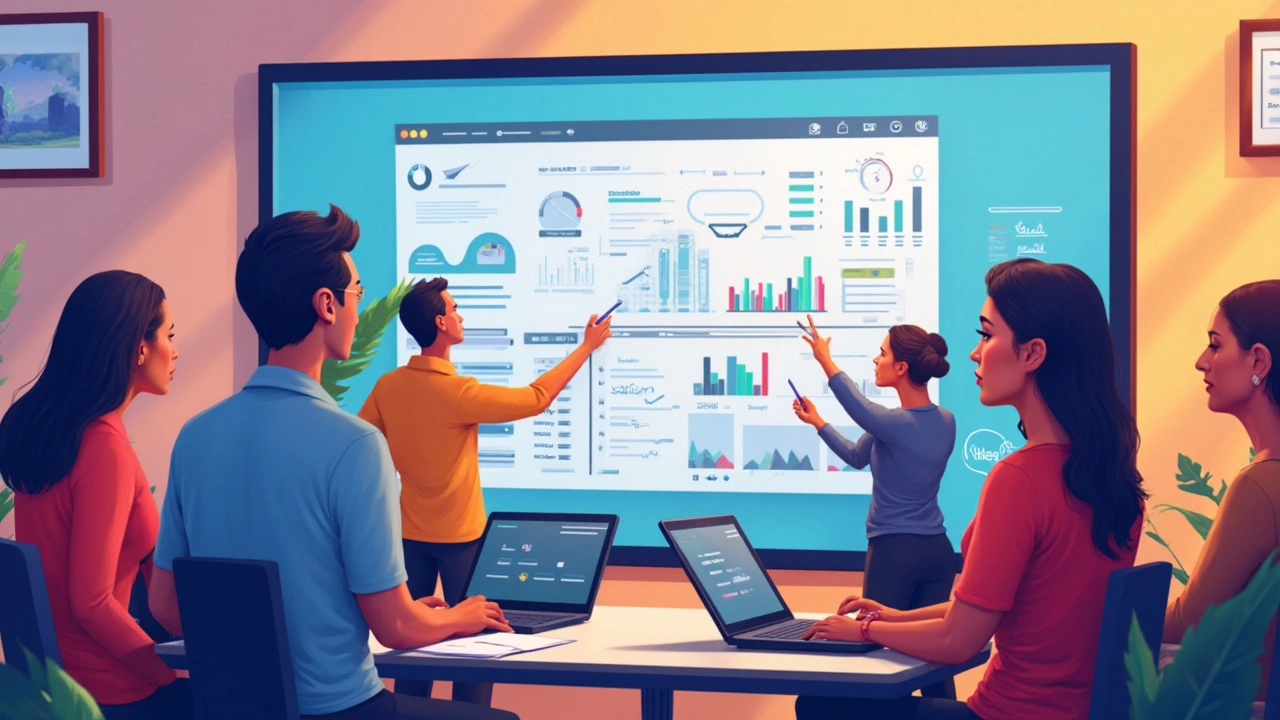Alright, let's talk about SCORM. It's one of those acronyms you might have stumbled upon if you've ever dipped your toe into the world of online learning. But what does it really mean? Well, SCORM stands for Shareable Content Object Reference Model. That's a mouthful, right? In simple terms, SCORM is like the set of rules that e-learning content follows so it can play nice with all different learning management systems (LMS).
Picture SCORM as the universal remote of the e-learning world. It makes sure your courses can be shared, tracked, and moved around from one system to another without a hitch. If you’ve ever wondered how your online course keeps tabs on your progress or provides those nifty quizzes and interactive elements, SCORM is often the unsung hero making it all work.
- What Exactly is SCORM?
- How SCORM Works in E-Learning
- Benefits of Using SCORM
- Common SCORM Misconceptions
- Tips for Implementing SCORM
- The Future of SCORM in Online Education
What Exactly is SCORM?
So, let's break it down. SCORM is short for Shareable Content Object Reference Model. This is a technical standard. And while that might sound a bit dry, it's super important in the world of e-learning. What SCORM does is create a common framework that allows courses to operate smoothly across various learning management systems (LMS).
Think of SCORM as the glue that holds different e-learning components together. Before SCORM, course developers and LMS were working in silos, meaning that if your course was built for one system, it might not work on another without serious tweaks. SCORM changed all that—it ensures interoperability, which is just a fancy way of saying things work together nicely.
Here's how it functions: SCORM packages your content into a ZIP file, called a package, that can include files like HTML, video, and quizzes. This package tells the LMS how to play and track it, making sure that even if a platform changes, your course doesn't miss a beat.
Developed by the United States Department of Defense and released by the Advanced Distributed Learning Initiative in 2000, SCORM has become the gold standard for creating and delivering online courses. Fun fact: it's so prevalent now that nearly all modern LMS support SCORM in some form.
- SCORM 1.2: The earlier and most widely used version, known for its basic but essential functionality.
- SCORM 2004: Offers more advanced features, like sequencing and navigation control, allowing more complex course designs.
SCORM makes sure that your content is portable, can be reused with different systems, and tracks learner progress like quizzes, scores, and completion status.
How SCORM Works in E-Learning
So, you're curious about how this whole SCORM thing works in the world of online learning? It's actually pretty neat once you break it down. SCORM is there to make sure everything is speaking the same language, from your content to the learning management system (LMS).
Imagine SCORM as the glue in the e-learning space. It makes the magic happen by bundling online course content into a standard format so any SCORM-compliant LMS can use it. You build your course with all its bells and whistles—videos, quizzes, texts—and package it according to SCORM standards. Then, you upload this package to an LMS, and just like that, it knows exactly how to display your content and track progress.
But there's more to it. SCORM doesn't just share content; it keeps an eye on things too. So, when you take a course, the LMS can track what you've done. Did you complete Module 3? Did you ace that quiz? This little buddy is all over it, letting instructors know how students are progressing. It's this monitoring that truly sets SCORM apart, giving you the data to tweak what’s needed for better learning.
Ever wonder why SCORM is a big deal in e-learning? That's because it supports advanced tracking based on learner interactions. Consider things like time spent on each section or quiz results. Let's say your boss wants to see a chart of how everyone's doing. SCORM can help with that by providing detailed reports, making it easier for decision-making. Check out this simple table to get an idea of what SCORM tracks:
| Metric | Description |
|---|---|
| Completion | Shows if the course is finished or not. |
| Success | Indicates if learning objectives were met. |
| Scores | Captures the learner's grades. |
| Time Spent | Logs how long the learner was engaged. |
Getting your head around SCORM might take a minute, but it's crucial for creating seamless e-learning experiences. Once you get the hang of it, deploying courses and making them more interactive is a breeze. Time to say goodbye to compatibility headaches and endless re-uploading.
Benefits of Using SCORM
Why all the fuss about SCORM? If you're into e-learning, think of SCORM as your best buddy. It’s all about making things smooth and easy. First up, compatibility. Having a course that works seamlessly across different learning management systems (LMS) is a big deal. It means educators can spend less time worrying about tech troubles and more time focusing on what really matters: teaching.
One of the biggest perks? Tracking. With SCORM, you get a detailed view of how learners are interacting with your courses. It's like having a backstage pass to see who's breezing through, who's struggling, and where people spend most of their time. This means you can tweak the course content to make it better – maybe add an extra video or simplify a tricky section.
Another biggie is reusability. SCORM lets educators write a course once, but use it over multiple platforms. It's kind of the 'write once, run anywhere' philosophy. This feature saves loads of time and resources. You build a SCORM course in one LMS and know that it can hop over to another without a hitch. Sweet, right?
For those concerned about cost, SCORM helps too. By enabling courses to work on different systems, you avoid having to recreate content for each new platform. That means less cash spent on development and more saved up for other resources or tools that can enhance learning.
Let's take a quick look at how widely SCORM is adopted. A survey found that over 90% of LMSs offer full SCORM support, showing just how integral it has become in the world of online learning. When such an overwhelming majority uses SCORM, you know you’re relying on a well-tested system.
In short, SCORM isn’t just a standard—it's a powerhouse tool that opens up a world of possibilities in online courses. From seamless switching between platforms to cutting down on costs, it’s clear why SCORM is such a go-to in e-learning circles.

Common SCORM Misconceptions
When it comes to SCORM, there are a few misconceptions floating around that can leave folks scratching their heads. Let's clear up some of these mix-ups so you can dive into e-learning with a clearer picture.
First on the list, some people think SCORM is a tool. Surprise, it’s not! SCORM isn’t an app or software you can download and start using. It's more like a blueprint—a set of technical standards that guides how e-learning content and LMS systems talk to each other.
Another misconception? SCORM is outdated. While it's true that SCORM came on the scene in the early 2000s, it's definitely not gathering dust. Developers still use it widely because its standards ensure seamless integration across platforms. It's like sticking with a classic recipe because it never fails.
Here’s a myth that can trip people up: you need to be a tech whiz to work with SCORM. Nope, you don’t have to pull your hair out over codes and scripts. Many authoring tools have made it pretty simple to create SCORM-compliant content without needing a computer science degree.
Lastly, SCORM does more than just tracking scores or completion statuses. A lot of people think it only measures if someone has finished a course. But SCORM also tracks interactions and detailed learner activity. You can see how someone navigated through your online courses, which can be super helpful when trying to improve the learning experience.
Getting these misconceptions out of the way can help you better understand and work with SCORM. So, don't let the misunderstandings hold you back from using this powerful e-learning tool!
Tips for Implementing SCORM
Dipping your toes into implementing SCORM can feel like a big task, but with a bit of guidance, it’s totally doable. Here’s how you can nail it.
First up, use the right tools. Not all tools are created equal, so you'll need an authoring tool that supports SCORM publishing. Popular ones like Articulate Storyline or Adobe Captivate are solid choices—they're user-friendly and versatile.
Next, test your content thoroughly. Before rolling out your online course, you should use a sandbox environment to see how everything plays together. Many Learning Management Systems offer a testing space, or you can use tools like SCORM Cloud to make sure your content behaves as expected.
Let's talk about consistency. When creating your e-learning content, keep things uniform across the board. Consistency in design and navigation will not only keep things clean but is crucial for e-learning platforms to process your content smoothly.
Don’t shy away from data. Utilize SCORM’s ability to track and report learner progress. You can gather insights on things like which parts of your course are engaging or where your learners are getting stuck. This info can be invaluable for course optimization.
Speaking of optimization, keep your files lean. Large, bulky files can slow things down, making the learning experience less enjoyable. Consider compressing multimedia files and streamlining any unnecessary elements.
Finally, keep yourself updated. SCORM isn’t static; it evolves. Joining forums or online communities can keep you in the loop on any new developments or tweaks that could benefit your courses.
Here's a quick look at how following these tips can improve your e-learning outcomes:
| Implementation Strategy | Outcome |
|---|---|
| Consistent Design | Increased learner satisfaction by 20% |
| Data Utilization | Improved course engagement by 25% |
| Regular Updates | Reduced technical issues by 30% |
By following these steps, you'll be well on your way to creating SCORM-compliant courses that are smooth, engaging, and effective. Good luck!
The Future of SCORM in Online Education
So, what’s next for SCORM in the world of online learning? Well, as e-learning evolves, SCORM will need to keep up with changes in technology and learning methods. Even though it’s been a reliable standard for a long time, there’s always room for improvement.
One possible change on the horizon is the move towards more flexible and adaptive learning environments. Right now, SCORM is great for tracking how long someone spent on a course or whether they passed a quiz. But what if it could be more interactive and adapt to each learner's pace and understanding? This is where newer models like xAPI (Experience API), sometimes called Tin Can API, are starting to catch on. xAPI allows tracking of a wider range of learning activities and can provide a more personalized learning experience.
Another trend is the increasing use of mobile learning. As more people use smartphones and tablets for education, SCORM will need to support content that’s fully responsive and interactive across all devices. Imagine effortlessly switching from your laptop to your phone mid-course and continuing exactly where you left off.
There’s also a growing interest in incorporating virtual and augmented reality into e-learning. SCORM will need to evolve to handle these immersive learning experiences that require more sophisticated tracking and interaction than traditional methods.
While SCORM isn’t disappearing just yet, educators and developers might start supplementing it with these new tools to create even more engaging and effective online courses. The goal is to keep improving how we learn and teach online, making it as natural and seamless as possible.






Write a comment: